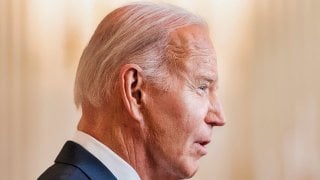The Federal Reserve Could Accidentally Start a Recession
Generals are said to “fight the last war” by failing to anticipate changed circumstances. Something similar might be said of the Federal Reserve under Jerome Powell.
Today’s stronger-than-expected GDP numbers make it very unlikely that the Federal Reserve will start an interest rate-cutting cycle at its policy meeting this week. This is a great pity, considering the multiple downside risks to the economic recovery that are now in plain sight. By the time the Fed starts cutting interest rates, it will likely be too late for the Fed to stave off an economic recession.
The distinguishing characteristic of the Jerome Powell Fed is its backward-looking monetary policy approach. In 2021, the Fed was inexcusably slow in raising interest rates at a time when there were clear signs of an acceleration in inflation. Today, the Fed is very slow in cutting interest rates. It is too slow at a time when there are clear signs that inflation is moderating and that downside risks to the economy are building.
A backward-looking Fed will likely say that today’s GDP numbers do not provide it with sufficient reassurance that inflation is coming down to its 2 percent inflation target on a sustainable basis. In defense of its position, the Fed will note that in the second quarter, GDP growth accelerated to a faster-than-expected 2.8 percent. It will also point out that the core personal consumer expenditure deflator, the Fed’s favorite inflation yardstick, ticked up 2.7 percent compared to a year ago.
The basic mistake that the Fed now appears to shopping habits following the pandemic, commercial property prices are dropping, and property developers are already starting to default on the $900 billion in property loans that fall due this year. This will hit the banks especially hard at a time when high interest rates have wrought serious damage on their loan and bond portfolios. It is estimated that the banks are currently sitting on more than $1 trillion in mark-to-market losses on those portfolios.
According to a recent National Bureau of Economic Research study, close to 400 small and medium-sized banks could fail due to high interest rates and the commercial property crisis. Were such failures to materialize, they would be reminiscent of the 1980s Savings and Loan Crisis, which contributed significantly to an economic recession.
Another risk that could derail the recovery is the United States’ drift toward protectionist policies, especially against China. One clear indication of this drift is the emphasis in the current election cycle on the need to protect American jobs from foreign competition. Donald Trump has made clear that if he wins the election, he will impose a 60 percent import tariff on China and a 10 percent across-the-board tariff on all other countries’ exports. That would carry the risk of retaliation by our trade partners and a return to the economically destructive beggar-thy-neighbor policies of the 1930s.
Looking abroad, there is no shortage of political and economic risks to which the Fed should be paying attention. Russia is still engaged in its war with Ukraine, while the Israel-Hamas War could spill over to the rest of the Middle East. China, the world’s second-largest economy and, until recently, its main engine of economic growth, is struggling to cope with the fallout from the bursting of its massive housing and equity bubble. Meanwhile, a heavily indebted and ungovernable France raises the specter of another round of Eurozone sovereign debt crises.
In 2021, at a time when the economy was recovering strongly and receiving its largest peacetime stimulus on record, the Powell Fed maintained interest rates at zero to keep a strong recovery going. That allowed the inflation genie out of the bottle. Today, at a time when the Fed’s high interest rates have caused inflation to moderate sharply and at a time when downside risks to the economy are building, the Fed is choosing to stick to its hawkish monetary policy stance. This heightens the chance that the Powell Fed will end up with contributing not only to the inflationary surge to a multi-decade high in 2022 but to an economic recession by early next year.
About the Author: Desmind Lachman
Desmond Lachman is a Senior Fellow at the American Enterprise Institute and was previously a Deputy Director in the International Monetary Fund’s Policy Development and Review Department as well as the Chief Emerging-Market Economic Strategist at Salomon Smith Barney.
Image: Shutterstock.com.


